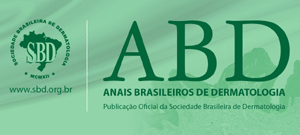|
|
-
Arival Cardoso de Brito, Universidade Federal do Pará (UFPA), Belém, PA, Brasil, Orcid: https://orcid.org/0000-0002-7133-5321, Lattes: http://lattes.cnpq.br/0563291980190339, e-mail: acdebrito@uol.com.br
-
Adriana Maria Porro, Universidade de São Paulo (USP), São Paulo, SP, Brasil, Orcid: https://orcid.org/0000-0003-0736-4790, Lattes: http://lattes.cnpq.br/7527051548277127, e-mail: adriana.porro@uol.com.br
-
Bogdana Victória Kadunc, Pontifícia Universidade Católica de Campinas (PUC), Campinas, SP, Brasil, Orcid: https://orcid.org/0000-0001-9093-3872, Lattes: http://lattes.cnpq.br/6363951717600008, e-mail: bog@uol.com.br
-
Cacilda da Silva Souza, Universidade de São Paulo (USP), São Paulo, SP, Brasil, Orcid: https://orcid.org/0000-0002-8157-7658, Lattes: http://lattes.cnpq.br/7285303481051362, e-mail: cssouza@fmrp.usp.br
-
Evandro A. Rivitti, Universidade de São Paulo (USP), São Paulo, SP, Brasil, Orcid: https://orcid.org/0000-0003-2454-1728, Lattes: http://lattes.cnpq.br/5390471117199997, e-mail: evandro.rivitti@gmail.com
-
Everton Carlos Siviero do Vale, American Academy of Dermatology (AAD), Rosemont, IL, Estados Unidos, Orcid: https://orcid.org/0000-0002-9172-3639, Lattes: http://lattes.cnpq.br/3451752957228846, e-mail: everton.vale@terra.com.br
-
Gerson Oliveira Penna, Fundação Oswaldo Cruz (FIOCRUZ), Brasília, DF, Brasil, Orcid: https://orcid.org/0000-0001-8967-536X, Lattes: http://lattes.cnpq.br/1312385303946378, e-mail: gerson.penna@fiocruz.br
-
Heitor de Sá Gonçalves, Universidade Estadual do Ceará (UECE) e Centro de Dermatologia Dona Libania (CDERM), Fortaleza, CE, Brasil, Orcid: https://orcid.org/0000-0001-9062-2580, Lattes: http://lattes.cnpq.br/8929040809605527, e-mail: heitorsg8@gmail.com
-
Hélio Miot, Universidade Estadual Paulista Júlio de Mesquita Filho (UNESP), São Paulo, SP, Brasil, Orcid: https://orcid.org/0000-0002-2596-9294, Lattes: http://lattes.cnpq.br/2543633050941005, e-mail: heliomiot@gmail.com
-
Ida Duarte, Faculdade de Ciências Médicas da Santa Casa de São Paulo (FCMSCSP) e Irmandade da Santa Casa de Misericórdia de São Paulo (ISCMSP), São Paulo, SP, Brasil, Orcid: https://orcid.org/0000-0001-6554-7005, Lattes: http://lattes.cnpq.br/8217480197206265, e-mail: rb.moc.arret@etraudadi
-
Ival Peres Rosa, Universidade Federal de São Paulo (UNIFESP), São Paulo, SP, Brasil, Orcid: https://orcid.org/0000-0002-8463-0071, e-mail: ivalperesrosa@gmail.com
-
Ivonise Follador, Universidade Federal da Bahia (UFBA) e Complexo Hospitalar Professor Edgard Santos (COMP.HUPES/UFBA), Salvador, BA, Brasil, Orcid: https://orcid.org/0000-0002-0261-0684, Lattes: http://lattes.cnpq.br/9673995600593898, e-mail: ifollador@hotmail.com
-
Izelda Costa, Universidade Católica de Brasília (UCB/DF), Brasília, DF, Brasil, Orcid: https://orcid.org/0000-0001-8133-2178, Lattes: http://lattes.cnpq.br/0056945699042193, e-mail: izelda.unb@gmail.com
-
Jesus Rodriguez Santamaria, Universidade Federal do Paraná (UFPR), Curitiba, PR, Brasil, Orcid: https://orcid.org/0009-0007-0056-9204, Lattes: http://lattes.cnpq.br/9890576565491303, e-mail: jsantamaria52@gmail.com
-
José Antônio Sanches Jr., Universidade de São Paulo (USP) e Hospital das Clínicas da Faculdade de Medicina de São Paulo (HCFMUSP), São Paulo, SP, Brasil, Orcid: https://orcid.org/0000-0002-5709-092X, Lattes: http://lattes.cnpq.br/6699884910788476, e-mail: jasanchesjr@gmail.com
-
Josemir Belo dos Santos, Universidade Federal de Pernambuco (UFPE), Recife, PE, Brasil, Orcid: https://orcid.org/0000-0002-6769-4743, Lattes: http://lattes.cnpq.br/9631328069233373, e-mail: josemirbelo@uol.com.br
-
Lauro Lourival Lopes Filho, Universidade Federal do Piauí, Teresina, PI, Brasil, Orcid: https://orcid.org/0000-0001-8777-1382, Lattes: http://lattes.cnpq.br/0449833455036523, e-mail: lllf@outlook.com.br
-
Luís Fernando F. Kopke, Imperial Hospital de Caridade (IHC) e KOPKE Dermatologia Clínico-Cirúrgica, Florianópolis, SC, Brasil, Orcid: https://orcid.org/0000-0002-3350-5887, Lattes: http://lattes.cnpq.br/9946066344455711, e-mail: luisfkopke@hotmail.com
-
Marcelo Grossi Araújo, Universidade Federal de Minas Gerais (UFMG), Belo Horizonte, MG, Brasil, Orcid: https://orcid.org/0000-0002-1483-3818, Lattes: http://lattes.cnpq.br/8427940110469573, e-mail: mgrossi@medicina.ufmg.br
-
Marcus A. Maia de Olivas Ferreira, Faculdade de Ciências Médicas da Santa Casa de São Paulo (FCMSCSP), São Paulo, SP, Brasil, Orcid: https://orcid.org/0000-0003-4111-1519, Lattes: http://lattes.cnpq.br/2145986062185182, e-mail: marcusmaiasp@uol.com.br
-
Mirian Nacagami Sotto, Universidade de São Paulo (USP), São Paulo, SP, Brasil, orcid: marcusmaiasp@uol.com.br, Lattes: http://lattes.cnpq.br/6392274014060705, e-mail: mnsotto@usp.br
-
Neusa Yuriko Sakai Valente, Hospital do Servidor Público Estadual de São Paulo e Universidade de São Paulo (USP), São Paulo, SP, Brasil, Orcid: https://orcid.org/0000-0002-8065-2695, Lattes: http://lattes.cnpq.br/8306942194626086, e-mail: neusasvalente@gmail.com
-
Nilton Di Chiacchio, Universidade de São Paulo (UNISA), São Paulo, SP, Brasil, Orcid: https://orcid.org/0000-0001-9536-2263, Lattes: http://lattes.cnpq.br/8952925869465107, e-mail: ndichia@terra.com.br
-
Paulo Ricardo Criado, Hospital das Clínicas da Faculdade de Medicina da USP (HCFMUSP), São Paulo, SP, Brasil, Orcid: https://orcid.org/0000-0001-9785-6099, Lattes: http://lattes.cnpq.br/6060355270823588, e-mail: prcriado@uol.com.br
-
Paulo Roberto Lima Machado, Universidade Federal da Bahia, Salvador, BA, Brasil, Orcid: https://orcid.org/0000-0003-1894-6171, Lattes: http://lattes.cnpq.br/7641162535517337, e-mail: prlmachado@hotmail.com
-
Pedro Bezerra da Trindade Neto, Universidade Federal do Rio Grande do Norte (UFRN), Natal, RN, Brasil, Orcid: https://orcid.org/0009-0003-9420-2980, Lattes: http://lattes.cnpq.br/7735798657833000, e-mail: ptrindade@uol.com.br
-
Renan Rangel Bonamigo, Universidade Federal do Rio Grande do Sul (UFRGS) e Hospital das Clínicas de Porto Alegre (HCPA), Porto Alegre, RS, Brasil, Orcid: https://orcid.org/0000-0003-4792-8466, Lattes: http://lattes.cnpq.br/3176625985912006, e-mail: rrbonamigo@gmail.com
-
Sinésio Talhari, Universidade Nilton Lins (UNL), Manus, AM, Brasil, Orcid: https://orcid.org/0000-0001-9753-6706, Lattes: http://lattes.cnpq.br/4447075735878106, e-mail: sinesio@dermatologiatalhari.com.br
-
Tania Cestari, Universidade Federal do Rio Grande do Sul (UFRGS), Porto Alegre, RS, Brasil, Orcid: https://orcid.org/0000-0003-3001-0202, Lattes: http://lattes.cnpq.br/4882921922989768, e-mail: cestari.tania@gmail.com
-
Vidal Haddad Jr., Universidade Estadual Paulista Júlio de Mesquita Filho (UNESP), São Paulo, SP, Brasil, Orcid: https://orcid.org/0000-0001-7214-0422, Lattes: http://lattes.cnpq.br/7385129302501798, e-mail: vidal.haddad-junior@unesp.br
-
Walter Belda Jr., Universidade de São Paulo (USP), São Paulo, SP, Brasil, Orcid: https://orcid.org/0000-0003-0401-1885, Lattes: http://lattes.cnpq.br/4579908948072154, e-mail: walterbelda26@gmail.com
|
|
